Elliott looks at pitchers with surprising starts recently. These SPs could emerge as fantasy baseball waiver wire targets for Week 4 in 2025, or just mirages.
Welcome back to the "Are You For Real?" series as we dive into Week 4 of the 2025 fantasy baseball season. For those who are not familiar, this is a weekly column where we take a look at starting pitchers who had surprisingly good starts over the past week and put them under the microscope to determine whether they're legitimate or just smoke and mirrors.
We've got three right-handers to look at this week. First, we'll check out the latest experiment from the Mets' pitching lab in Griffin Canning, who dominated the Cardinals on Thursday. Then, we'll deep dive into Landen Roupp's awesome start against the Angels this weekend. We'll finish it out by looking at Luis L. Ortiz's recent hot stretch.
Roster percentages are taken from Yahoo! and are accurate as of April 21.
Be sure to check all of our fantasy baseball lineup tools and resources:- Fantasy baseball trade analyzer
- BvP matchups data (Batter vs. Pitcher)
- PvB matchups data (Pitcher vs. Batter)
- Who should I start? Fantasy baseball comparisons
- Daily MLB starting lineups
- Fantasy baseball closer depth charts
- Fantasy Baseball live scoreboard
- Fantasy baseball injury reports
Griffin Canning, New York Mets
7% Rostered
2025 Stats (prior to this start): 15 IP, 4.20 ERA, 4.63 FIP, 7.7% K-BB%
4/17 vs. STL: 6 IP, 3 H, 1 ER, 2 BB, 8 K
Canning turned in his best start of the young season on Thursday, holding St. Louis to just one run over six innings while striking out eight. Canning had some offseason buzz as one of the latest reclamation projects to go through the Mets' pitching lab. Did he come out better for it, or can(ning) we ignore Griffin?
Originally a second-round pick by the Angels back in 2017, Canning had some prospect pedigree as he advanced through the Angels’ system. He was viewed as someone who could be a mid-rotation starter with his deep arsenal. Canning uses a six-pitch mix consisting of a four-seam fastball, slider, changeup, cutter, curveball, and sinker.
It may seem like a lot of pitches, but Canning has primarily relied on three of them this season, which are the four-seamer, slider, and changeup. All three were on display against St. Louis, and Canning has thrown the three pitches a combined 94.5 percent of the time.
The most significant change for Canning in 2025 is increased slider usage. He threw his slider 24 percent of the time last season, but he’s used it 36.5 percent of the time thus far in 2025. An 87.2 mph offering, the slider boasts some impressive measurements, including a 6.2-inch vertical drop above the league average.
Canning also gained four inches of drop with the pitch compared to last season. Here’s an example of the pitch from this start.
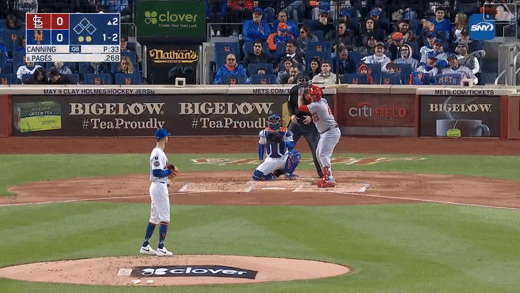
That’s some filthy drop, and Canning has fooled batters often with the pitch this season. He earned six of his 16 whiffs with the slider on Thursday, good for a 46 percent whiff rate. Overall, he has a 34.2 percent whiff rate with the pitch this season, along with a monster 44.6 percent chase rate. Canning’s slider has the makings of a legitimate strikeout pitch, and he should be able to maintain his current 23.9 percent strikeout rate.
The slider isn’t the only changed pitch for Canning. His fastball looks to be revamped as well. Canning is throwing with the same velocity at 93.4 mph, but he’s gained two inches of horizontal movement with his fastball this season compared to last year. Let’s compare his four-seam fastball shape from 2024 to 2025.
2024:
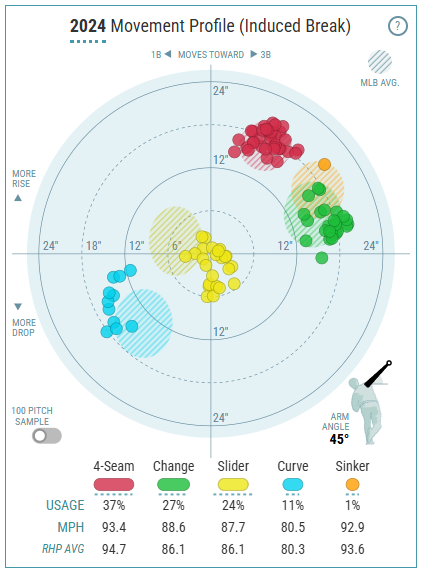
2025:
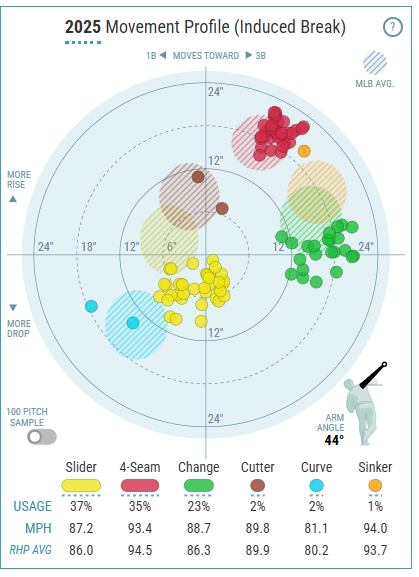
He has a rather average shape in 2024, but in 2025, we can see the impact of his increased horizontal break. It’s having a profound impact on batted balls against his four-seam fastball as well. Batters have a 25.5 percent ground-ball rate off Canning’s four-seam fastball all time, but they have a 60 percent ground-ball rate this season.
Opponents have really struggled against Canning’s fastball overall as well, hitting just .111 with a .111 SLG and .184 wOBA. The expected stats suggest that Canning has earned these results as well, with a .130 xBA, .176 xSLG, and .213 xwOBA against.
I don’t expect the .200 BABIP against or the 0 percent line drive rate against to hold, but Canning’s fastball looks new and improved for 2025, and he should get better results than he’s had in the past.
Canning rounds out his repertoire with an 88.7 mph changeup, which he’s used 23.1 percent of the time this season. He only threw it 18 percent of the time against St. Louis and earned three of his 16 whiffs with the pitch, good for a 30 percent whiff rate. Canning’s changeup doesn’t measure out as impressively as his previously discussed pitches, but he has gained two inches of drop with it this season.
Batters have handled it well enough, hitting .273 with a .409 SLG and .346 wOBA. He also has a .302 xBA and .367 xwOBA against, along with a 94.6 mph average exit velocity against the pitch. He’s gotten better results with the pitch over the course of his career, so perhaps Canning can even things out, but as it stands, the changeup seems a level behind the slider and four-seam fastball.e He
Canning does have three other pitches, the curveball, sinker, and cutter, but he’s thrown each pitch under 2.5 percent of the time this season. Perhaps this is part of the Mets' new approach. After all, these pitches haven’t had the best results in the major leagues.
Batters have a .253 AVG and .494 SLG off Canning’s curveball all time. They’re also hitting .364 against his sinker all time. Perhaps by simplifying Canning’s arsenal, the Mets can extract the value we know exists in this right arm.
Verdict:
The Mets have had great success with reclamation projects over the past few years, and Canning could be their newest find. He’s displayed increased movement on his slider, which could lead to more whiffs and strikeouts with the pitch. He’s also improved the movement on his four-seam fastball and is inducing more favorable contact as a result.
His changeup gives him a solid third pitch, if unremarkable. Canning seems to have pared down his arsenal to rely heavily on his three best pitches, the slider, four-seamer, and changeup. Whether this works for him long term remains to be seen, but this is a step in the right direction, and Canning is an intriguing waiver wire add as a result.
He’s worth adding in 12-team leagues or deeper.
Landen Roupp, San Francisco Giants
28% Rostered
2025 Stats (prior to this start): 15 IP, 4.80 ERA, 2.62 FIP, 19.4% K-BB%
4/19 @ LAA: 7 IP, 5 H, 2 ER, 1 BB, 9 K
Roupp was fantastic on Saturday, fanning nine Angels en route to his second consecutive victory. Roupp has been a strikeout machine, posting at least eight strikeouts in three of his first four starts and putting up an impressive 11.86 K/9. Pitchers with strikeout upside like this are always interesting, but can Roupp sustain this performance?
Originally a 12th-round pick out of UNC-Wilmington, Roupp wasn’t viewed as much of a prospect coming up through San Francisco’s system. He was ranked as the Giants' 18th-best prospect by Fangraphs in 2024 at the age of 25, with Roupp being viewed as a likely reliever going forward.
Roupp works with a four-pitch mix consisting of a curveball, sinker, changeup, and cutter. He leans heavily on the curveball and sinker, throwing the pitches a combined 89 percent of the time in this start and 80.4 percent of the time on the year.
Roupp’s most-used pitch is his curveball, which he threw 45 percent of the time against the Angels. A 77.1 mph offering, Roupp’s curveball is best characterized by its extreme horizontal movement and high spin rate. He averages 3029 RPM with the pitch, and his curveball moves 6.6 inches above the league average.
Have a look at his curveball shape.
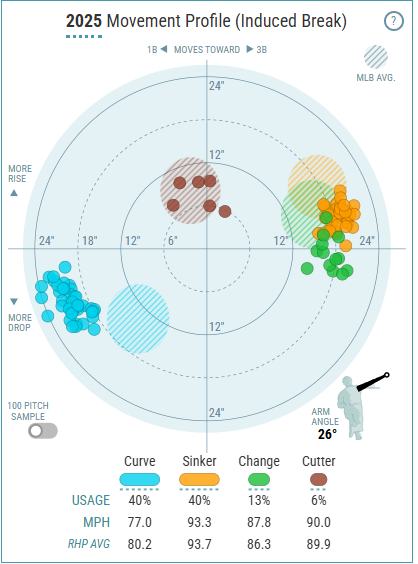
And have a look at his curveball in action in this start.
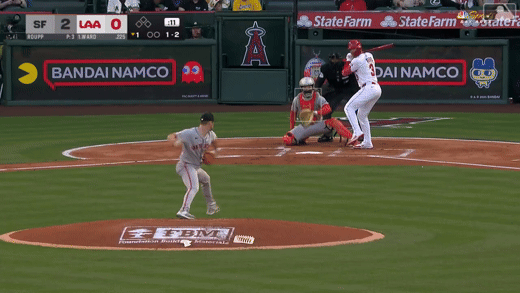

Not easy to make Mike Trout look like that (though he did serve up two home runs to Trout later), and Roupp was racking up the whiffs on his curveball all night. He notched 12 of his 18 whiffs with his curveball on Saturday. Batters are really struggling against this pitch, hitting just .115 with a .269 SLG and .202 wOBA against it.
The expected stats suggest that Roupp has also earned these results, with a .135 xBA, .241 xSLG, and .199 xwOBA. He also has a monster 55.6 percent whiff rate and 39.8 percent chase rate with the pitch. There’s a lot to like about Roupp’s curveball. While I don’t expect Roupp to maintain a 31.2 percent strikeout rate, his curveball has the makings of a dominant strikeout offering.
Then there’s Roupp’s sinker, which he threw 44 percent of the time against the Angels. A 93.3 mph offering, Roupp’s sinker has some exceptional movement as well. Let’s have a look at his movement profile again.

The sinker does sink, and batters would likely swing over the pitch, driving it into the ground. Unfortunately, that hasn’t happened for Roupp too often this season. His sinker has been crushed for a .417 AVG, .500 SLG, and .445 wOBA against.
Those numbers are bad, but the expected stats suggest that Roupp has gotten unlucky results with his sinker. He has a .253 xBA, .305 xSLG, and .308 xwOBA with his sinker this season, numbers more in line with last year’s results.
The .429 BABIP against his sinker should drop closer to .300, giving him better outcomes. We might also expect more groundballs from Roupp going forward, as he had a two-degree launch angle and a 60.7 percent ground-ball rate against his sinker last season, but a 12-degree average launch angle and 51.9 percent ground-ball rate against it this season.
He’s been a good ground-ball pitcher throughout the minors, so it’d be reasonable to expect the ground-ball rate to rise on his sinker and for him to get better results overall. It’s not as sexy as his curveball, but it’s a solid offering.
Roupp rounds out his arsenal with a changeup and cutter, though the changeup is his true third pitch, and he throws it about 14 percent of the time. An 87.9 mph offering, Roupp’s changeup does have exceptional vertical movement and has earned good strikeout numbers in the past. He only had two whiffs with it in this start, but he only threw it eight times total and had a 50 percent whiff rate.
Overall, Roupp has a 37.5 percent whiff rate and a 38.1 percent chase rate with the pitch this season.
Like the sinker, Roupp has had some poor results, but they seem like bad luck rather than a lack of skill. Batters are hitting .375 against Roupp’s changeup with a .500 SLG and .417 wOBA, but they have a .215 xBA, .316 xSLG, and .282 xwOBA. Now, keep in mind that we’re still dealing with a small sample size, but the numbers suggest that Roupp can perform better over time. There’s just no way he carries a .500 BABIP against his changeup all season.
Roupp’s changeup again isn’t as sexy as his curveball, but it’s a good third pitch to solidify a major league repertoire.
Verdict:
Roupp has been racking up the strikeouts thanks to a deadly curveball-sinker combo. His curveball has both impressive measurables and results, and it appears to be a bona fide strikeout pitch. With this pitch alone, Roupp could carve out a career in the bullpen.
He does have a full starter’s arsenal, however, with a solid sinker and a changeup he can wield against hitters from both sides of the plate. Don’t expect him to maintain a 31.2 percent strikeout rate, but Roupp should be a plus strikeout pitcher. He should also get better results once his .358 BABIP against and 15 percent HR/FB ratio normalize towards league average.
Roupp is a must-add in 12-team leagues or deeper; there’s a lot of upside here.
Luis L. Ortiz, Cleveland Guardians
14% Rostered
2024 Stats (prior to this start): 16.1 IP, 6.06 ERA, 4.69 FIP, 12.7% K-BB%
4/18 @ PIT: 5 IP, 4 H, 2 ER, 3 BB, 8 K
Ortiz has been a strikeout machine lately, racking up 18 strikeouts over his last two starts, spanning 10 2/3 innings. He has an elevated 24.7 percent strikeout rate on the year and has put together three straight solid outings after being clobbered for seven runs in his first appearance. Is Ortiz turning a corner, or just taking advantage of weak opponents?
Initially signed by the Pirates as an international free agent, this was a revenge game for Ortiz, as he was traded from Pittsburgh to Cleveland this past offseason. Ortiz works with a five-pitch mix consisting of a four-seam fastball, slider, cutter, changeup, and sinker.
He mixes in all five pitches with some regularity, throwing each pitch at least nine percent of the time. He likes to lean mostly on the four-seamer, slider, and cutter, however, throwing each pitch at least 20 percent of the time this season.
Ortiz’s most-used pitch in this start was his four-seam fastball, which he threw 33 percent of the time and earned three of his 14 whiffs with the pitch. A 96.1 mph offering, Ortiz’s velocity was slightly up in this outing at 96.8 mph.
Ortiz’s four-seam fastball is best characterized by plus horizontal break and below-average vertical drop. He has above-average velocity, but average spin at 2274 RPM. For the most part, batters have hit well against the pitch.
Opponents are hitting .276 with a .552 SLG and .404 wOBA off Ortiz’s four-seamer this season, although the .247 xBA, .475 xSLG, and .360 xwOBA suggest that Ortiz has been a little unlucky with his four-seamer. Even so, the expected stats aren’t exactly blowing us away, and Ortiz could be susceptible to power.
He managed to surrender 1.1 HR/9 while pitching half his games in pitcher-friendly PNC Park during his tenure with the Pirates. Ortiz has also given up four home runs in his last three starts despite having a 3.24 ERA over that stretch.
Ortiz has fly-ball tendencies with a 16-degree average launch angle and a 94.9 mph average exit velocity against his fastball this season. He does have a solid 33.9 percent whiff rate with the pitch, but I wouldn’t expect him to maintain that throughout the season.
Ortiz had a 20.9 percent whiff rate with his four-seam last year and a 15.2 percent whiff rate with it the year before. It’s just not a strikeout pitch. Ortiz managed to get eight whiffs with it in his 10-strikeout performance against Kansas City on April 12, but that result seems fluky compared to his past performance and the pitch's measurables.
Ortiz’s best strikeout pitch is probably his slider, which he threw 27 percent of the time against Pittsburgh. He also earned seven of his 14 whiffs with the pitch on Friday, good for a 39 percent whiff rate. Ortiz’s slider has slightly above-average movement and average spin at 2,378 RPM.
Here’s an example from this start.
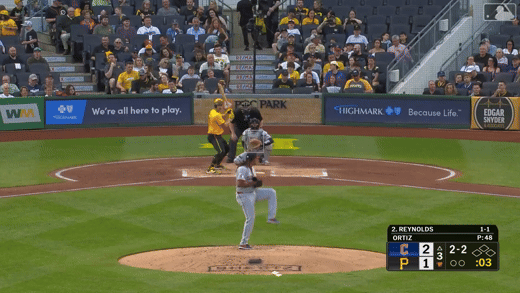
Pretty good pitch, and Ortiz isn’t afraid to use it against left-handed hitters either. Still, batters have handled the pitch relatively well this season. Opponents are hitting .269 with a .538 SLG and .359 wOBA against. Like with his four-seamer, the expected stats suggest that Ortiz has been a little unlucky, but the expected stats still aren’t great.
He has a .243 xBA, .490 xSLG, and .323 xwOBA against his slider this season. He does have an impressive 20.2 percent swinging-strike rate and a 47.6 percent chase rate with the pitch this season, but I’m not sure I expect those numbers to hold either.
He has a 15.4 percent swinging-strike rate and a 33.6 percent chase rate with his slider all time. He's not doing anything differently to suggest that these leaps are sustainable.
Ortiz also used his cutter 22 percent of the time in this start. A 90.9 mph offering, the cutter has painfully average movement and spin. Again, opponents have hit the pitch well with a .300 AVG, .400 SLG, and .352 wOBA against.
The expected stats do not suggest that Ortiz has been unlucky either, as he has a .295 xBA, .352 xSLG, and .331 xwOBA against this pitch. The cutter looks like a nice change of pace between the fastball and slider combo, but ultimately, I'm not impressed by this pitch.
The one thing Ortiz does well with the pitch is induce infield fly-balls, as he has a 28.6 percent infield fly-ball rate with his cutter all time. That’s not a good enough skill to trust him in my fantasy lineup. His last two starts came against two bottom-four offenses against right-handed pitchers, and I can’t trust him against anyone more formidable.
Verdict:
Ortiz has done a great job taking advantage of weak opposition, but that’s all that this recent hot stretch seems to be. The Royals have a .258 wOBA against right-handed pitching, worst in the league, while the Pirates are barely better at .280.
Ortiz has plus velocity and movement with his four-seamer, but not enough to think his 33.9 percent whiff rate is sustainable. His slider and cutter are both rather average pitches, and I wouldn’t expect Ortiz to maintain the gaudy strikeout numbers that we’ve seen.
Ortiz has proven himself good enough to be streamable against weak opponents, but I wouldn’t trust him against even an average offense.
Download Our Free News & Alerts Mobile App
Like what you see? Download our updated fantasy baseball app for iPhone and Android with 24x7 player news, injury alerts, sleepers, prospects & more. All free!

More Fantasy Baseball Advice





 RADIO
RADIO
























